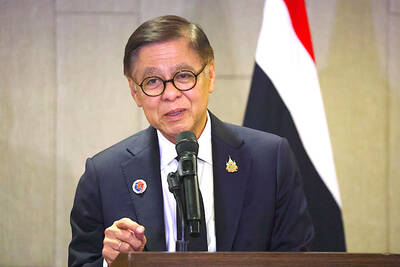Mexico’s government allowed a group of undercover US anti-drug agents and their Colombian informant to launder millions of US dollars in cash for a powerful Mexican drug trafficker and his Colombian cocaine supplier, according to documents made public on Monday.
The Mexican magazine Emeequis published portions of documents that describe how US Drug Enforcement Administration (DEA) agents, a Colombian trafficker-turned-informant and Mexican federal police officers in 2007 infiltrated the Beltran Leyva drug cartel and a cell of money launderers for Colombia’s Valle del Norte cartel in Mexico.
The group of officials conducted at least 15 wire transfers to banks in the US, Canada and China, and smuggled and laundered about US$2.5 million in the US. They lost track of much of that money.
The DEA agent in charge of the operation testified that drug administration agents posing as pilots flew at least one shipment of cocaine from Ecuador to Madrid through a Dallas airport.
The documents are part of an extradition order against Harold Mauricio Poveda-Ortega, a Colombian arrested in Mexico in 2010 on charges of supplying cocaine to Arturo Beltran Leyva. A year earlier, Beltran Leyva was killed in a shootout with Mexican marines in the city of Cuernavaca, south of Mexico City.
The documents show Mexico approved Poveda-Ortega’s extradition to the US in May, but neither Mexican nor US authorities would confirm whether he has been extradited. Mexican authorities listed his first name as “Haroldo.”
In a statement issued late on Monday, Mexico’s Attorney General’s Office said it cooperates with the US in combating money laundering and said the Poveda-Ortega case, like others of its kind, “are carried out strictly within the legal framework.”
While the statement said: “Coordinated money laundering investigations are carried out exclusively by Mexican authorities,” it also noted that “sometimes, these investigations require specialized techniques to detect money laundering, which each agency carries out within its own jurisdiction.”
US officials did not respond to requests for comment.
The documents offer rare glimpses into the way US anti-drug agents are operating in Mexico, an often sensitive subject in a country touchy about national sovereignty.
On one occasion, the informant who began working for the DEA in 2003 after a drug arrest met with the girlfriend of a Colombian drug trafficker in Dallas and offered to move cocaine for their group around the world for US$1,000 per kilo. The informant then introduced the woman to a DEA agent posing as a pilot. The woman is identified as the girlfriend of Horley Rengifo Pareja, who was detained in 2007 accused of laundering money and drug trafficking.
Another scene described the informant negotiating a deal to move a cocaine shipment from Ecuador to Spain and minutes later being taken to a house where he met with Arturo Beltran Leyva.
Beltran Leyva was once a top lieutenant for the Sinaloa drug cartel, led by Joaquin “El Chapo” Guzman. However, he split from the cartel shortly after his brother was arrested in 2008, setting off a bloody battle between the former allies.

REVENGE: Trump said he had the support of the Syrian government for the strikes, which took place in response to an Islamic State attack on US soldiers last week The US launched large-scale airstrikes on more than 70 targets across Syria, the Pentagon said on Friday, fulfilling US President Donald Trump’s vow to strike back after the killing of two US soldiers. “This is not the beginning of a war — it is a declaration of vengeance,” US Secretary of Defense Pete Hegseth wrote on social media. “Today, we hunted and we killed our enemies. Lots of them. And we will continue.” The US Central Command said that fighter jets, attack helicopters and artillery targeted ISIS infrastructure and weapon sites. “All terrorists who are evil enough to attack Americans are hereby warned

Seven wild Asiatic elephants were killed and a calf was injured when a high-speed passenger train collided with a herd crossing the tracks in India’s northeastern state of Assam early yesterday, local authorities said. The train driver spotted the herd of about 100 elephants and used the emergency brakes, but the train still hit some of the animals, Indian Railways spokesman Kapinjal Kishore Sharma told reporters. Five train coaches and the engine derailed following the impact, but there were no human casualties, Sharma said. Veterinarians carried out autopsies on the dead elephants, which were to be buried later in the day. The accident site

RUSHED: The US pushed for the October deal to be ready for a ceremony with Trump, but sometimes it takes time to create an agreement that can hold, a Thai official said Defense officials from Thailand and Cambodia are to meet tomorrow to discuss the possibility of resuming a ceasefire between the two countries, Thailand’s top diplomat said yesterday, as border fighting entered a third week. A ceasefire agreement in October was rushed to ensure it could be witnessed by US President Donald Trump and lacked sufficient details to ensure the deal to end the armed conflict would hold, Thai Minister of Foreign Affairs Sihasak Phuangketkeow said after an ASEAN foreign ministers’ meeting in Kuala Lumpur. The two countries agreed to hold talks using their General Border Committee, an established bilateral mechanism, with Thailand

‘POLITICAL LOYALTY’: The move breaks with decades of precedent among US administrations, which have tended to leave career ambassadors in their posts US President Donald Trump’s administration has ordered dozens of US ambassadors to step down, people familiar with the matter said, a precedent-breaking recall that would leave embassies abroad without US Senate-confirmed leadership. The envoys, career diplomats who were almost all named to their jobs under former US president Joe Biden, were told over the phone in the past few days they needed to depart in the next few weeks, the people said. They would not be fired, but finding new roles would be a challenge given that many are far along in their careers and opportunities for senior diplomats can